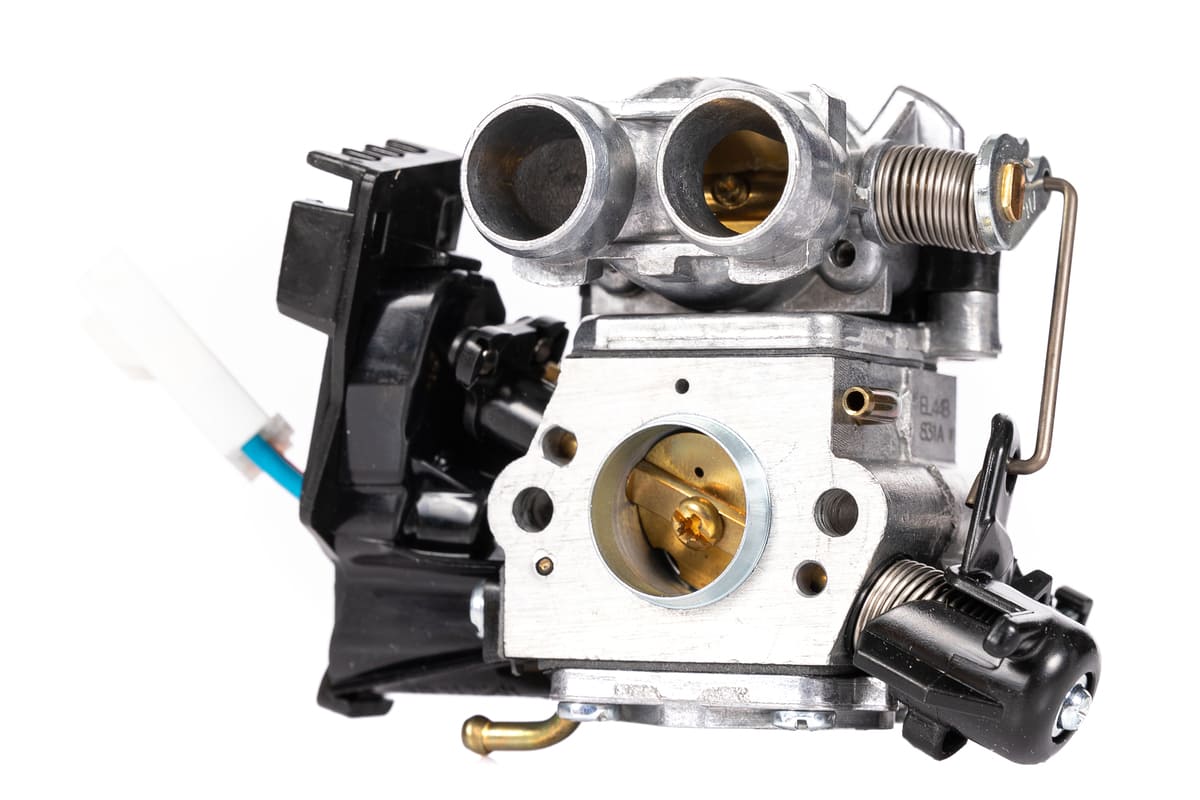Carburetors deliver the right mix of air and fuel to the engine’s cylinders. Found mostly in old cars, motorcycles and small machinery, they make combustion efficient, power, efficiency and overall performance.
What Is a Carburetor?
A carburetor is a device in engines that mixes air and fuel. It gets the right amount of each to the engine’s cylinders.
In a carburetor, air enters through an opening. It goes through a narrow tube called a venturi. This tube speeds up the air and creates a vacuum.
This vacuum pulls fuel from a small pipe called a jet. The fuel mixes with the fast air. Then it goes into the engine’s cylinders.
The carburetor has a throttle valve to control how much air-fuel mixture enters the . When you press the gas pedal this valve opens more.
Some carburetors have a choke valve. This valve helps start the engine in cold conditions by restricting the air flow, making the mixture richer in fuel.
Carburetors are adjustable. Mechanics can tune them for better performance or fuel efficiency. They use screws to change the fuel and air mix.
Though modern cars mostly use fuel injection, carburetors still work in small engines like those in motorcycles, lawnmowers and old cars.
References
- Carburetor. Retrieved from
- Carburetor. Britannica. Retrieved from
- Carburetor. ScienceDirect. Retrieved from
What Does a Carburetor Do in an Engine?
The functions of a carburetor in an engine are:
- The main function of a carburetor is to mix air and fuel to make a combustion mixture.
- A carburetor controls engine speed.
- A carburetor controls the ratio of air and fuel in different engine conditions.
- It keeps a certain amount of fluid always floating in chambers.
- It controls the ratio of air and fluid.
- It evaporates the oil or gasoline to make a homogeneous mixture of air and fuel.
References
- How long do wipers last?. Retrieved from
How Does a Carburetor Work?
A carburetor helps the engine mix air and fuel. This mix is important for the engine to run. Let’s break it down step by step.
Step 1: Air Intake
Air enters the carburetor through an opening. Then it goes through a narrow tube called a venturi. The venturi speeds up the air.
Step 2: Fuel Mixing
As the air speeds up, it creates a vacuum. This vacuum pulls fuel from a small pipe called a jet. The fuel mixes with the fast air.
Step 3: Throttle Control
The carburetor has a throttle valve that controls how much of this air-fuel mix goes into the engine. When you press the gas pedal this valve opens more, letting in more mix.
Step 4: Fuel Adjustment
Some carburetors have a choke valve to help start the engine in cold conditions. The choke restricts the air flow, making the mix richer in fuel. This helps the engine to start easier.
Step 5: Tuning
Mechanics can tune the carburetor to change the air-fuel mix. They use screws to make the engine perform better or use less fuel.
By following these steps the carburetor ensures the engine gets the right air-fuel mix.
References
- Carburetors. Universal Technical Institute. Retrieved from
What are the Types of Carburetors?
Carburetors come in different types, each with its own features. These types help engines get the right air-fuel mix. Let’s see the main types.
Single-Barrel Carburetor
A single-barrel carburetor has one venturi and one jet. It’s simple and works for small engines like lawnmowers and basic cars.
Two-Barrel Carburetor
A two-barrel carburetor has two venturis and two jets. It’s better than a single-barrel. Many medium sized cars use this type.
Four-Barrel Carburetor
A four-barrel carburetor has four venturis and four jets. It’s common in high performance cars and trucks. It’s great at high speeds.
Downdraft Carburetor
In a downdraft carburetor air flows down into the engine. This design allows gravity to help mix fuel and air, it’s efficient.
Sidedraft Carburetor
A sidedraft carburetor lets air flow sideways into the engine. It’s used in sports cars where engine space is limited.
Updraft Carburetor
In an updraft carburetor air flows up into the engine. It’s an older design but still works in some tractors and generators.
Each type of carburetor has its own advantages and uses. Knowing these types will help you choose the right one for your engine.
What Are the Components of a Carburetor?
A carburetor has several components that work together to mix air and fuel. Knowing these components will help you understand how a carburetor works.
Here are the main parts of a carburetor:
- Throttle Valve
- Choke Valve
- Venturi
- Float Chamber
- Jet
- Idle Mixture Screw
- Main Metering System
- Accelerator Pump
- Air Bleeds
- Fuel Bowl
These components ensure the carburetor delivers the right air-fuel mix to the engine.
References
- Carburetors: Components, Functions, and How They Work. Wuling Motors. Retrieved from
- What is a Carburetor?. GoDigit. Retrieved from
Why is it Necessary to Clean the Carburetor Regularly?
Cleaning the carburetor regularly makes the engine run smoothly. Dirt and debris can clog its tiny parts and cause poor performance.
When the carburetor is dirty the air-fuel mix is unbalanced. This can cause hard starts, rough idling and poor fuel efficiency.
A clean carburetor allows fuel to flow freely through the jets. It maintains optimal engine power and smooth acceleration.
Over time varnish from old fuel can build up inside the carburetor. Cleaning removes this buildup and prevent damage and costly repairs.
Regular maintenance also extends the life of the carburetor. It will prevent sudden breakdowns and make your engine reliable and efficient.
References
- Carburetor. BankBazaar. Retrieved from https://www.bankbazaar.com/two-wheeler-insurance/guide/carburetor.html


